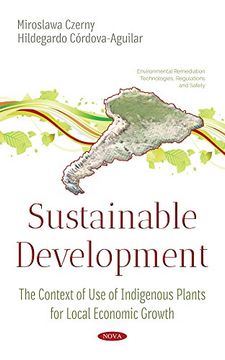Sustainable Development: The Context of use of Indigenous Plants for Local Economic Growth (Environmental Remediation Technologies, Regulations and Safety) (en Inglés)
Reseña del libro "Sustainable Development: The Context of use of Indigenous Plants for Local Economic Growth (Environmental Remediation Technologies, Regulations and Safety) (en Inglés)"
Sustainability has become, in recent years, essential to any approach regarding development. However, the word itself has a different meaning in economic development, politics, cultural evolution and heritage, resource management and other contexts. The main meaning for the purpose of this book is that sustainability seems to be an uncomplete concept since it does not take into consideration the achievements in science and technology which alter our understanding of criteria, like durability, persistence and sustainability itself. In discussions concerning the proper management of resources and changes in the structure of the basket of resources that still remain at the disposal of humankind, the key players are human beings, with their consumption models, habits and dependence on products originating from the surrounding environment. It is quite well-known that sustainable development is regarded as a concept by which to overcome or at least ease glaring economic and social disparities between the industrialised and the developing countries not only for today, but also for the future. The assumption here holds that poverty and constant shortages facing a majority within the society of each developing country favour an over-exploitation and chaotic use of resources. The over-exploitation showing little or no care for the natural environment is pursued by individuals, small-scale entrepreneurs, and by large concerns that destroy the environment with impunity. We refer here to sustainability as a concept applied to integral rural development in peripheral regions such as the sierra of Piura in northwestern Peru and Viques in the Mantaro Valley of Central Peru. The development of rural areas in the Peruvian Andes is mainly linked with agricultural activity. Since pre-Columbian times, the management of land for farming has represented the greatest challenge for those inhabiting the region in question. The scarce resources that arable land inevitably represented here was subject to special protection. In the case of Frias, one of the key indexes where peripherally and marginalisation are concerned is the one relating to the low level of education attained. In the case of Viques, this peripherability is mainly due to its altitude and weather conditions, where crops are limited to only a few. On the other hand, our argument here is that the sustainability is a concept that needs to extend to the management of natural renewable resources, which grow wild in the Andes Mountains and have little attention by local householders. Here, we offer a number of plant fruits which may promote rural development of peripheral rural populations by providing complementary nutritional intakes as well as some extra money to satisfy other human needs. We also refer to a number of medicinal plants widely used by both the rural and urban populations, especially after the growing interest in natural medicine.

